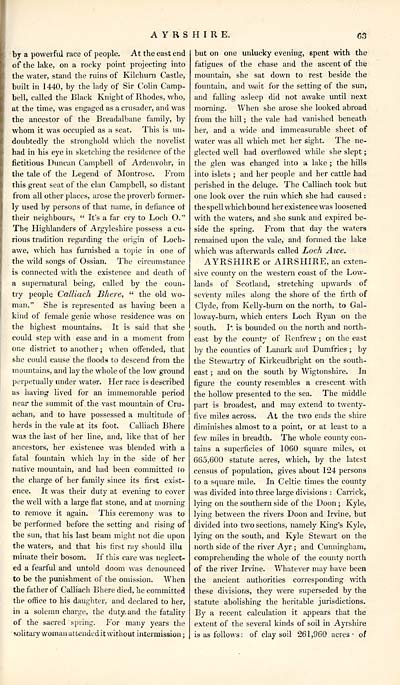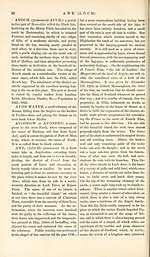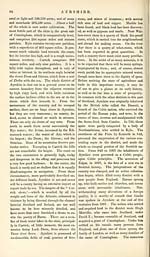Gazetteer of Scotland > Volume 1
(91) Page 63
Download files
Complete book:
Individual page:
Thumbnail gallery: Grid view | List view

AYRSHIRE.
G3
by a powerful race of people. At the east end
of the lake, on a rocky point projecting into
the water, stand the ruins of Kilchum Castle,
built in 1440, by the lady of Sir Colin Camp-
bell, called the Black Knight of Rhodes, who,
at the time, was engaged as a crusader, and was
the ancestor of the Breadalbane family, by
whom it was occupied as a seat. This is un-
doubtedly the stronghold which the novelist
had in his eye in sketching the residence of the
fictitious Duncan Campbell of Ardenvohr, in
the tale of the Legend of Montrose. From
this great seat of the clan Campbell, so distant
from all other places, arose the proverb former-
ly used by persons of that name, in defiance of
their neighbours, " It's a far cry to Loch O."
The Highlanders of Argyleshire possess a cu-
rious tradition regarding the origin of Loch-
awe, which has furnished a topic in one of
the wild songs of Ossian. The circumstance
is connected with the existence and death of
a supernatural being, called by the coun-
try people Calliach Bhere, " the old wo-
man." She is represented as having been a
kind of female genie whose residence was on
the highest mountains. It is said that she
could step with ease and in a moment from
one district to another ; when offended, that
she could cause the floods to descend from the
mountains, and lay the whole of the low ground
perpetually under water. Her race is described
as having lived for an immemorable period
near* the summit of the vast mountain of Cru-
achan, and to have possessed a multitude of
herds in the vale at its foot. Calliach Bhere
was the iast of her line, and, like that of her
ancestors, her existence was blended with a
fatal fountain which lay in the side of her
native mountain, and had been committed to
the charge of her family since its first exist-
ence. It was their duty at evening to cover
the well with a large flat stone, and at morning
to remove it again. This ceremony was to
be performed before the setting and rising of
the sun, that his last beam might not die upon
the waters, and that his first ray should illu
initiate their bosom. If this care was neglect-
ed a fearful and untold doom was denounced
to be the punishment of the omission. When
the father of Calliach Bhere died, he committed
the office to his daughter, and declared to her,
in a solemn charge, the duty and the fatality
of the sacred spring. For many years the
solitary woman attended it without intermission ;
but on one unlucky evening, 6pent with the
fatigues of the chase and the ascent of the
mountain, she sat down to rest beside the
fountain, and w*iit for the setting of the sun,
and falling asleep did not awake until next
morning. When she arose she looked abroad
from the hill ; the vale had vanished beneath
her, and a wide and immeasurable sheet of
water was all which met her sight. The ne-
glected well had overflowed while she slept ;
the glen was changed into a lake ; the hills
into islets ; and her people and her cattle had
perished in the deluge. The Calliach took but
one look over the ruin which she had caused :
the spell whichbound her existence was loosened
with the waters, and she sunk and expired be-
side the spring. From that day the waters
remained upon the vale, and formed the lake
which was afterwards called Loch Awe.
AYRSHIRE or AIRSHIRE, an exten-
sive county on the western coast of the Low-
lands of Scotland, stretching upwards of
seventy miles along the shore of the firth of
Clyde, from Kelly-bum on the north, to Gal-
loway-burn, which enters Loch Ryan on the
south. I* is bounded on the north and north-
east by the county of Renfrew ; on the east
by the counties of Lanark and Dumfries ; by
the Stewartry of Kirkcudbright on the south-
east ; and on the south by Wigtonshire. In
figure the county resembles a crescent with
the hollow presented to the sea. The middle
part is broadest, and may extend to twenty-
five miles across. At the two ends the shire
diminishes almost to a point, or at least to a
few miles in breadth. The whole county con-
tains a superficies of 1060 square miles, 01
665,600 statute acres, which, by the latest
census of population, gives about 124 persons
to a square mile. In Celtic times the county
was divided into three large divisions : Carrick,
lying on the southern side of the Doon ; Kyle,
lying between the rivers Doon and Irvine, but
divided into two sections, namely King's Kyle,
lying on the south, and Kyle Stewart on the
north side of the river Ayr ; and Cunningham,
comprehending the whole of the county north
of the river Irvine. Whatever may have been
the ancient authorities corresponding with
these divisions, they were superseded by the
statute abolishing the heritable jurisdictions.
By a recent calculation it appears that the
extent of the several kinds of soil in Ayrshire
is as follows: of clay soil 261,960 acres- of
G3
by a powerful race of people. At the east end
of the lake, on a rocky point projecting into
the water, stand the ruins of Kilchum Castle,
built in 1440, by the lady of Sir Colin Camp-
bell, called the Black Knight of Rhodes, who,
at the time, was engaged as a crusader, and was
the ancestor of the Breadalbane family, by
whom it was occupied as a seat. This is un-
doubtedly the stronghold which the novelist
had in his eye in sketching the residence of the
fictitious Duncan Campbell of Ardenvohr, in
the tale of the Legend of Montrose. From
this great seat of the clan Campbell, so distant
from all other places, arose the proverb former-
ly used by persons of that name, in defiance of
their neighbours, " It's a far cry to Loch O."
The Highlanders of Argyleshire possess a cu-
rious tradition regarding the origin of Loch-
awe, which has furnished a topic in one of
the wild songs of Ossian. The circumstance
is connected with the existence and death of
a supernatural being, called by the coun-
try people Calliach Bhere, " the old wo-
man." She is represented as having been a
kind of female genie whose residence was on
the highest mountains. It is said that she
could step with ease and in a moment from
one district to another ; when offended, that
she could cause the floods to descend from the
mountains, and lay the whole of the low ground
perpetually under water. Her race is described
as having lived for an immemorable period
near* the summit of the vast mountain of Cru-
achan, and to have possessed a multitude of
herds in the vale at its foot. Calliach Bhere
was the iast of her line, and, like that of her
ancestors, her existence was blended with a
fatal fountain which lay in the side of her
native mountain, and had been committed to
the charge of her family since its first exist-
ence. It was their duty at evening to cover
the well with a large flat stone, and at morning
to remove it again. This ceremony was to
be performed before the setting and rising of
the sun, that his last beam might not die upon
the waters, and that his first ray should illu
initiate their bosom. If this care was neglect-
ed a fearful and untold doom was denounced
to be the punishment of the omission. When
the father of Calliach Bhere died, he committed
the office to his daughter, and declared to her,
in a solemn charge, the duty and the fatality
of the sacred spring. For many years the
solitary woman attended it without intermission ;
but on one unlucky evening, 6pent with the
fatigues of the chase and the ascent of the
mountain, she sat down to rest beside the
fountain, and w*iit for the setting of the sun,
and falling asleep did not awake until next
morning. When she arose she looked abroad
from the hill ; the vale had vanished beneath
her, and a wide and immeasurable sheet of
water was all which met her sight. The ne-
glected well had overflowed while she slept ;
the glen was changed into a lake ; the hills
into islets ; and her people and her cattle had
perished in the deluge. The Calliach took but
one look over the ruin which she had caused :
the spell whichbound her existence was loosened
with the waters, and she sunk and expired be-
side the spring. From that day the waters
remained upon the vale, and formed the lake
which was afterwards called Loch Awe.
AYRSHIRE or AIRSHIRE, an exten-
sive county on the western coast of the Low-
lands of Scotland, stretching upwards of
seventy miles along the shore of the firth of
Clyde, from Kelly-bum on the north, to Gal-
loway-burn, which enters Loch Ryan on the
south. I* is bounded on the north and north-
east by the county of Renfrew ; on the east
by the counties of Lanark and Dumfries ; by
the Stewartry of Kirkcudbright on the south-
east ; and on the south by Wigtonshire. In
figure the county resembles a crescent with
the hollow presented to the sea. The middle
part is broadest, and may extend to twenty-
five miles across. At the two ends the shire
diminishes almost to a point, or at least to a
few miles in breadth. The whole county con-
tains a superficies of 1060 square miles, 01
665,600 statute acres, which, by the latest
census of population, gives about 124 persons
to a square mile. In Celtic times the county
was divided into three large divisions : Carrick,
lying on the southern side of the Doon ; Kyle,
lying between the rivers Doon and Irvine, but
divided into two sections, namely King's Kyle,
lying on the south, and Kyle Stewart on the
north side of the river Ayr ; and Cunningham,
comprehending the whole of the county north
of the river Irvine. Whatever may have been
the ancient authorities corresponding with
these divisions, they were superseded by the
statute abolishing the heritable jurisdictions.
By a recent calculation it appears that the
extent of the several kinds of soil in Ayrshire
is as follows: of clay soil 261,960 acres- of
Set display mode to: Large image | Transcription
Images and transcriptions on this page, including medium image downloads, may be used under the Creative Commons Attribution 4.0 International Licence unless otherwise stated. ![]()
| Gazetteers of Scotland, 1803-1901 > Gazetteer of Scotland > Volume 1 > (91) Page 63 |
|---|
| Permanent URL | https://digital.nls.uk/97425454 |
|---|
| Description | Volume I: Abbey to Glenartney. |
|---|---|
| Attribution and copyright: |
|
| Description | By Robert Chambers and William Chambers. Glasgow: Blackie & Son, 1838. 2 volumes. |
|---|---|
| Shelfmark | NF.1461.g.7 |
| Additional NLS resources: | |

